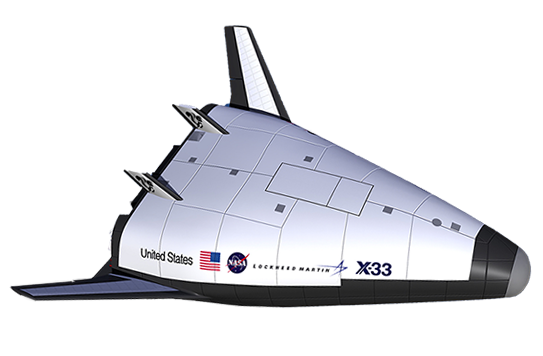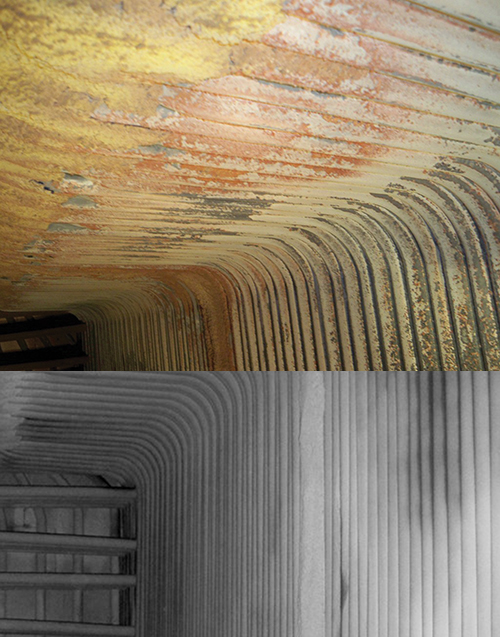
High-Temperature Coatings Offer Energy Savings
NASA Technology
The U.S. X-Plane Program included the first-of-its-kind research in aerodynamics and astronautics with experimental vehicles, including the first aircraft to break the sound barrier; the first aircraft to fly in excess of 100,000, then 200,000, and then 300,000 feet; and the first aircraft to fly at three, four, five, and then six times the speed of sound.
During the 1990s, NASA started developing a new thermal protection material to test on the X-33 and X-34 supersonic aircraft. The X-33 was intended to demonstrate the technologies needed for a new reusable launch vehicle and was projected to reach an altitude of approximately 50 miles and speeds of more than Mach 11. The X-34, a small, reusable technology demonstrator for a launch vehicle, was intended to reach an altitude of 250,000 feet and fly at speeds of Mach 8.
As a result of its research and development efforts, NASA’s Ames Research Center invented the Protective Ceramic Coating Material (PCCM). Applied to a surface, the thin, lightweight coating could protect the material underneath from extreme temperatures. The capability of the technology came from its emissivity, which radiated heat away from the surface it covered, thereby decreasing the amount of heat transferred to the underlying material. PCCM not only increased the capability of materials to withstand higher temperatures, it also exhibited impressive thermal shock, vibration, and acoustic performance. In addition, it proved to be resistant to abrasion and mechanical damage and was also environmentally safe, due to it being water-based and containing no solvents. Even though funding for the X-33 and X-34 ended in 2001, PCCM continued on a path of innovation.
Partnership
Shortly after Ames made PCCM available for licensing, Emisshield Inc. (then Wessex Incorporated) in Blacksburg, Virginia, stumbled upon the technology, and according to John Olver, president and CEO of Emisshield, “After we looked it over, analyzed it, read about it, and checked on some of the references, we called Ames and said we’d like to license it. We wanted to know how they did that.”
Olver and other representatives from Emisshield talked to the NASA inventors to learn more about PCCM, and in 1996, obtained a license for the technology. With assistance from the Center for Adhesion and Sealant Sciences at the Virginia Polytechnic Institute and State University (Virginia Tech), Emisshield performed extensive testing, research, and development of the coating. By 2001, the company had expanded its license agreement to include all applications except space and space vehicle applications.
During the first few years, Emisshield made several changes to make PCCM more practical to use. One of the properties Emisshield adjusted was the shelf life of the material. “When you mixed it up, it set like concrete in about an hour. You couldn’t use it after that,” Olver says. Emisshield also modified PCCM so it would adhere to metal and was easy to apply with a spray gun.
“As we progressed, we took the base license and advanced it into two new patents,” says Olver. “NASA said, ‘That’s what we intended for you to do, to license it, make it better, and commercialize it.’”
Benefits
Previously featured in Spinoff 2001 and Spinoff 2004, Emisshield provides its NASA-derived technology, also called Emisshield, in more than 20 different products. Each formulation is different based on the material it is being applied to as well as the temperature and conditions of the environment. “We are changing the surface properties of existing materials—metals, ceramics—to improve their performance,” says Olver. “It will work just about anywhere there is heat—from electricity to manufacturing glass and plastic bottles.”
Available for use on new or existing substrates in any combustion process including metals, refractory (heat resistant material), ceramics, and high technology fabrics, Emisshield can provide significant savings for most energy consuming, producing, or related heat systems. According to its customers, Emisshield has permitted heat-driven industrial applications to experience up to a 15-percent energy savings, a 15-percent increase in production, more uniform heating, prolonged substrate life, and reduced downtime for maintenance. In fact, the company finds the harder a process is pushed, the greater the fuel savings and the faster the payback for using Emisshield.
“Another thing that happens is that by improving combustion of gasses and fuels, products are made with less energy, and that reduces air emissions,” says Olver. All of this is done with a coating that is about as thin as a kitchen garbage bag. The coating can be applied to items at an Emisshield facility, or onsite at a customer’s facility. “It’s unique because it is so easy to install, even in the field and for applications that have extreme requirements. We can go out, clean the surface, and then apply the coating.”
In hydrocarbon and chemical processing, Emisshield can be used to coat the combustion chamber and process tubes of high temperature cracking units, as well as lower temperature process heaters. Emisshield is applied to the process tubes and refractory walls, a combination that generates an increase in energy savings and production. Like applications in the hydrocarbon and chemical processing industry, power generation can also see similar benefits while promoting better air emissions. Such applications include biomass boilers, waste incinerators, natural gas boilers, heat recovery steam generators, and burners.
For metal production, applications include reheat furnaces, bell annealing furnaces, walking beam furnaces, electric arc furnaces, and others. The increase in combustion allows for a quicker heat up and cool down in an intermittent furnace, which saves manufacturers time and money. Emisshield is also used in a variety of multipurpose kilns including intermittent kilns and continuous kilns.
One of Emisshield’s most popular applications is in furnaces for making glass—everything from wine bottles to windshields. So far, the coating has been applied to 30 furnaces worldwide. “On these big glass furnaces, they are saving about 10 percent of their energy,” says Olver. “The payback for our clients making glass is always under a year.”
As the company moves forward, it strives to penetrate new market areas. Recently, the company started focusing on introducing Emisshield in the food processing industry. The company is working to apply the coating on the walls of ovens, baking pans, and burners for commercial bread baking. “We see lots of opportunities in this market, and are hoping to push into it in the next few years,” says Olver. “Emisshield could even be applied to the grills that people use at home. There are a lot of potential applications.”
The newest application, however, is for high solar absorptive materials for concentrated solar power generation stations. The company is currently working with an Israeli-U.S. company in this area.
“We started the root system with NASA, then the trunk, and now we’re growing our branches,” says Olver. “We wouldn’t be here if it weren’t for technology transfer from NASA.”
Emisshield® is registered by Emisshield Inc.

Emisshield Inc. licensed technology from NASA to incorporate into various formulations of coatings for high-temperature applications. The images show the walls of a boiler before (top) and after (bottom) the NASA-derived coating was applied.

In developing new materials to test on the X-33 reusable launch vehicle (artist’s concept shown here), Ames Research Center invented a thin material capable of withstanding high temperatures. It also exhibited good thermal shock, vibration, and acoustic performance.













